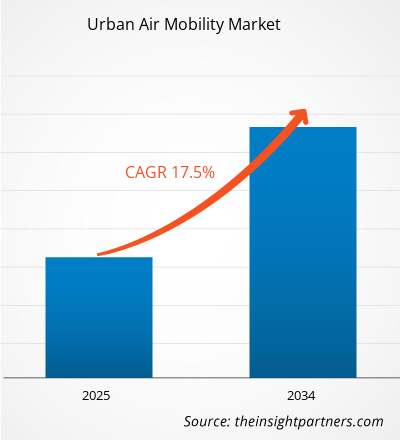도심 항공 모빌리티 시장은 2025년에 63억 8,490만 달러 규모로 성장할 것으로 예상되며, 2034년에는 232억 5,030만 달러에 이를 것으로 예상됩니다. 또한 2025년부터 2034년까지 연평균 성장률(CAGR) 17.5%로 성장할 것으로 예상됩니다.
도심 항공 모빌리티 여객 운송 수단은 최소 3명에서 최대 5~6명의 승객이 이용할 수 있습니다. 시골 지역에서는 필요에 따라 6명 이상의 승객이 삼륜차 여객 운송 수단으로 이동합니다. 도시 교통 체증 심화는 시장 성장을 견인하는 주요 요인입니다. 전 세계 도시 인구가 증가함에 따라 교통 체증은 사람들의 삶의 질에 심각한 영향을 미치고 있으며, 전반적인 경제 성장에도 악영향을 미치고 있습니다. 예를 들어, 교통 분석 회사인 INRIX에 따르면 미국 통근자는 교통 체증이 가장 심한 시간대에 매년 약 41시간을 교통 체증에 허비합니다. 또한 교통 체증으로 인해 2017년에 미국 운전자들이 약 3,050억 달러의 손실을 입었으며, 이는 운전자 한 명당 평균 1,445달러에 해당한다고 언급했습니다. 나아가 미국 환경보호청은 승용차 한 대가 매년 평균 4.7톤의 이산화탄소를 배출한다고 추산했습니다. 더욱이 인도와 중국과 같은 개발도상국에서 자동차 소유가 증가함에 따라 자동차 사고도 급증했습니다. 세계보건기구(WHO)에 따르면 매년 약 125만 명이 자동차 사고로 사망하며, 하루 평균 사망자 수는 약 3,400명에 이릅니다. 여기에는 치명적이지 않은 사고로 인한 수백만 건의 부상은 포함되지 않았습니다.
글로벌 도시 항공 이동성 시장은 승객 운송 수단과 화물 운송 수단으로 구분됩니다. 연료 유형에 따라 도시 항공 이동성 시장은 디젤, 휘발유, CNG, LPG, 전기로 구분됩니다. 전기 도시 항공 이동성에 대한 수요 증가, 인구 증가, 그리고 해당 지역의 교통 체증을 해소하는 데 도움이 되는 차량에 대한 필요성 증가로 인해 글로벌 도시 항공 이동성 시장이 성장하고 있습니다.
요구 사항에 맞게 이 보고서를 사용자 정의하십시오.
이 보고서의 일부, 국가 수준 분석, Excel 데이터 팩을 포함하여 모든 보고서에 대한 사용자 정의를 무료로 받을 수 있을 뿐만 아니라 스타트업 및 대학을 위한 훌륭한 제안 및 할인을 이용할 수 있습니다
도시 항공 모빌리티 시장: 전략적 통찰력

-
이 보고서의 주요 주요 시장 동향을 확인하세요.이 무료 샘플에는 시장 동향부터 추정 및 예측에 이르기까지 데이터 분석이 포함됩니다.
항공 기술의 발전은 대도시 지역의 사람과 화물을 위한 편리하고 효율적인 온디맨드 교통 서비스를 제공할 수 있는 잠재력을 창출하고 있습니다. 도시 항공 모빌리티(UAM)는 사회적 이동성을 재구축할 수 있는 교통 개념입니다. UAM은 기존 도로 교통 인프라의 부담을 덜어줌으로써 지상 교통 체증을 줄일 수 있는 매우 저렴하고 접근성이 뛰어나며 빠른 도시 항공 교통을 제안합니다. UAM은 분산형 전기 추진, 애플리케이션 기반 승차 공유와 같은 새로운 비즈니스 모델, 그리고 생산 비용을 절감할 첨단 항공우주 제조 기술 등의 이점을 활용합니다. 차량 자동화 및 자율주행차 운행의 신뢰도를 높이는 것은 자율 UAM 비전을 달성하는 데 매우 중요합니다. 예상되는 높은 수요를 감당할 수 있는 경제적으로 실현 가능한 교통 시스템을 위해서는 자율성이 필수적입니다. 안정적이고 기동성이 뛰어난 수직 이착륙(VTOL) 차량과 고도로 자동화된 비행의 기술 성숙도가 크게 향상됨에 따라 UAM 산업이 크게 성장할 것입니다.
플랫폼 기반 시장 분석
도심 항공 모빌리티 시장은 플랫폼에 따라 에어 택시, 승객용 항공기, 화물용 항공기, 그리고 항공 구급차로 구분됩니다. UAM은 화물과 사람을 쉽고 빠르게 운송하는 데 필요한 다양한 응용 분야를 제공합니다. 이러한 UAM은 소형 물품, 의료품 운송뿐 아니라 승객 수송에도 널리 활용됩니다. 그러나 이러한 모빌리티 솔루션은 용도에 따라 비행 한계가 있습니다. UAM 차량은 중대형 건물이나 고층 건물에 충돌할 수 있는 저거리 비행이나 항공사에 충돌할 수 있는 고거리 비행이 허용되지 않습니다.
운영 기반 시장 분석
도심 항공 모빌리티 시장은 운영 방식에 따라 유인 및 자율 비행으로 구분됩니다. 자율 주행 eVTOL은 화물 및 승객 운송에 더 적합하며 도시간 운송에 점점 더 많이 활용될 것으로 예상됨에 따라 예측 기간 동안 자율 주행 부문이 시장을 주도할 것으로 예상됩니다.
도심 항공 모빌리티 시장에서 활동하는 기업들은 시장 주도권 확보, 인수, 제품 출시 등 다양한 전략에 집중하여 시장 내 입지를 굳건히 하고 있습니다. 주요 기업들의 몇 가지 발전 사항은 다음과 같습니다.
2020년 2월, 에어버스와 싱가포르 민간항공청(Civil Aviation Authority of Singapore)은 싱가포르의 도심 항공 모빌리티 활성화를 위한 양해각서(MOU)를 체결했습니다. 이 협력을 통해 싱가포르의 도심 항공 모빌리티가 가능해질 것입니다.
2019년 2월, 에어스페이스 익스피리언스 테크놀로지스(Airspace Experience Technologies)는 스피릿 에어로시스템즈(Spirit AeroSystems)와 인증된 완전 전기 수직 이착륙(eVTOL) 항공기 개발을 위한 최종 계약을 체결했습니다.
도시 항공 모빌리티 시장 지역별 통찰력
The Insight Partners의 분석가들은 예측 기간 동안 도시 항공 모빌리티 시장에 영향을 미치는 지역별 동향과 요인들을 면밀히 분석했습니다. 이 섹션에서는 북미, 유럽, 아시아 태평양, 중동 및 아프리카, 그리고 중남미 지역의 도시 항공 모빌리티 시장 세분화 및 지역별 분포도 살펴봅니다.
도시 항공 모빌리티 시장 보고서 범위
| 보고서 속성 | 세부 |
|---|---|
| 시장 규모 2025 | US$ 6,384.9 Million |
| 시장규모별 2034 | US$ 23,250.3 Million |
| 글로벌 CAGR (2025 - 2034) | 17.5% |
| 이전 데이터 | 2021-2022 |
| 예측 기간 | 2025-2034 |
| 다루는 세그먼트 |
By 플랫폼
|
| 포함된 지역 및 국가 |
북미
|
| 시장 선도 기업 및 주요 회사 프로필 |
|
도시 항공 모빌리티 시장 참여자 밀도: 비즈니스 역학에 미치는 영향 이해
도심 항공 모빌리티 시장은 소비자 선호도 변화, 기술 발전, 그리고 제품 이점에 대한 인식 제고 등의 요인으로 인한 최종 사용자 수요 증가에 힘입어 빠르게 성장하고 있습니다. 수요가 증가함에 따라 기업들은 제품 및 서비스를 확장하고, 소비자 니즈를 충족하기 위한 혁신을 추진하며, 새로운 트렌드를 적극 활용하고 있으며, 이는 시장 성장을 더욱 가속화하고 있습니다.

- 을 얻으세요 도시 항공 모빌리티 시장 주요 주요 플레이어 개요
- 에어 택시
- 승객용 항공기
- 화물용 항공기
- 항공 구급차
도시 항공 모빌리티 시장 - 운영별
- 조종
- 자율주행
도시 항공 모빌리티 시장 - 지역별
-
북미
- 미국
- 캐나다
-
유럽
- 프랑스
- 독일
- 영국
- 러시아
- 유럽의 나머지 지역
-
세계의 나머지 지역
도시 항공 모빌리티 시장 - 회사 프로필
- Airbus SAS
- Aurora Flight Sciences
- Bell Helicopter Textron Inc.
- EHang
- EmbraerX
- Honeywell International Inc.
- Kitty Hawk
- Moog Inc.
- Volocopter GmbH
- 과거 분석(2년), 기준 연도, CAGR을 포함한 예측(7년)
- PEST 및 SWOT 분석
- 시장 규모 가치/거래량 - 글로벌, 지역, 국가
- 산업 및 경쟁 환경
- Excel 데이터세트
최근 보고서
관련 보고서
사용 후기
구매 이유
- 정보에 기반한 의사 결정
- 시장 역학 이해
- 경쟁 분석
- 고객 인사이트
- 시장 예측
- 위험 완화
- 전략 기획
- 투자 타당성 분석
- 신흥 시장 파악
- 마케팅 전략 강화
- 운영 효율성 향상
- 규제 동향에 발맞춰 대응






















 무료 샘플 받기 - 도시 항공 모빌리티 시장
무료 샘플 받기 - 도시 항공 모빌리티 시장